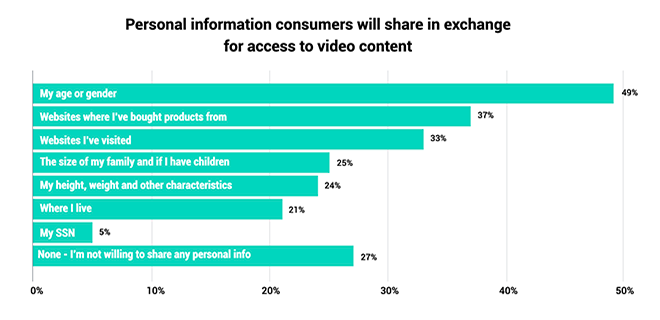
Consumers are willing to engage with video ads and share their data with the caveat that publishers and advertisers make them compelling and relevant to their interests.
Consumers encounter a digital ecosystem oversaturated with content and choices. This places advertisers and publishers on a perpetual quest to create an ideal and strategic viewer experience. And with the surge of online video consumption, the environment has become especially dynamic.
As consumers spend more time online, their exposure to video ads grows, raising critical questions: Are consumers still paying attention to video ads? Do they consider video ads an unnecessary interruption, or are they willing to trade their time and data for affordable access to the content they desire?
Connatix conducted a comprehensive survey — Consumers are Watching; Here’s How They Want Their Video Ads — of over 1,000 U.S. consumers aged 18 and above to delve into these queries. The study aims to understand the types of videos consumers prefer, their viewing preferences, and how contextual alignment can impact engagement.
Consumers Will Watch Video Ads But Have Some Requests
Amidst the plethora of digital choices, specific platforms have emerged as top destinations for video consumption. Social channels like Facebook, Instagram, and TikTok captured the attention of 81% of those surveyed. Notably, publishers’ websites (45%) and mobile apps (41%) also draw a robust audience.
However, audience preferences vary by demographic. For instance, younger and more social media-savvy individuals tend to favor social channels, while more affluent viewers and older demographics exhibit a stronger inclination toward publishers’ websites. This diverse pattern underscores publishers’ and advertisers’ need for tailored content strategies to reach their target audiences effectively.
Where and What They Watch: Important Takeaways
Viewer Preferences and Publisher Engagement. Younger generations and lower-income individuals are inclined to watch video content on social media platforms. This preference aligns with their social media savviness and accessibility to such platforms. In contrast, more affluent and older viewers are more likely to visit publishers’ websites for video content. This insight is crucial for publishers aiming to tailor their content experiences to specific demographics and advertisers seeking to broaden their reach effectively.
Content Type Preferences. Viewers under 55 predominantly prefer entertainment videos from publishers, whereas older demographics favor news content. Understanding these content type preferences is vital for publishers to curate and deliver content that resonates with their audience and advertisers to align their messages effectively.
The Importance of Trustworthy News. Trustworthy news is essential for a well-functioning democracy and society. Advertisers utilizing broad keyword blocklists often miss out on highly engaged audiences due to concerns about brand safety. Using platforms like Connatix, which leverage NewsGuard’s ratings, can help advertisers approach news as a category safely and invest in quality journalism, ultimately benefiting both advertisers and publishers.
Viewers Will Trade Their Time and Data for Access to Desired Content. Today’s consumers are well aware of the role advertising plays in granting them access to the desired content. The survey shows their willingness to engage with advertisements, showcasing that viewers are ready to trade their time and data for access to the content they seek. Eighty-four percent of respondents, spanning various demographics, express a readiness to watch a video ad on their favorite website to unlock desired video content.
Publishers’ Impact: Enhancing the Viewing Experience
Publishers play a vital role in delivering video content to viewers. Publishers should focus on enhancing the viewing experience to cater to evolving viewer expectations. Here are key considerations:
Audio Enhancement: As more consumers watch videos with sound, publishers should consider using audio to enhance stories by incorporating catchy music or valuable voice-overs. This can significantly improve the overall viewing experience and captivate the audience.
Contextual Alignment: Viewers seek alignment between content and ads and between content and recommended articles. Publishers with contextual data can use these insights to recommend additional articles and videos to keep readers engaged and on the site longer. Sharing this data with advertisers can also enable smarter targeting decisions.
Engaging On-Site Experiences: Consumers prefer to stay within a handful of publisher properties rather than jump between multiple destinations to consume content. Publishers can increase viewer engagement by developing captivating on-site experiences that attract desired audiences and encourage longer time spent on their pages.
Understanding consumer preferences and behavior for consuming video content, including advertising, is crucial for both advertisers and publishers. For publishers seeking to capture the surge in video ad spend, adapting strategies to align with these preferences can lead to a more effective and engaging viewer experience, benefitting all stakeholders in the digital advertising ecosystem.
To download the full report, visit Connatix here.

